Short T.A. Electric Power Distribution Handbook
Подождите немного. Документ загружается.


588
Electric Power Distribution Handbook
The voltage impulse easily breaks down most distribution-class insulation
unless it is protected with a surge arrester. Almost all direct lightning strokes
cause flashovers. In addition, the lightning current may start a pole fire or
burn through conductors. Also, nearby lightning strokes that do not hit the
line may couple damaging voltages to the line. These induced voltages may
fail equipment or cause flashovers.
Figure 12.1(a) shows an example of a lightning flash composed of several
individual strokes hitting a distribution circuit (the movement of the light-
ning channel and camera shaking makes it easier to distinguish the individ-
ual strokes). Two phases initially flashed over, and the third eventually
flashed over (either due to a subsequent stroke or the gasses from the initial
fault). On three-phase circuits, lightning normally causes two- or three-phase
faults. The lightning-caused fault in Figure 12.1(a) resulted in a downed-
wire high-impedance fault that was not cleared by the station protection (the
circuit was tripped manually). Taken moments after the lightning flash,
Figure 12.1(b) shows the glow of an arcing downed conductor. In this case,
the 60-Hz fault arc, not the original lightning impulse, burned the wires
down. Two characteristics made this circuit prone to burndowns: covered
wire and relaying that allowed long-duration faults (the instantaneous relay
in the substation did not cover this portion of the line). The second bright
blob in the lower right of the lightning strike picture is another flashover
further down the line on the same circuit. These supplementary flashovers
— away from the fault point and on the same circuit — are common, espe-
cially in areas with high ground impedances (the ground potential rise
pushes the surge to other locations on the circuit). These pictures were taken
by a lightning-activated camera developed by the Niagara Mohawk Power
Corporation (now part of National Grid) (Barker and Burns, 1993).
Locations with higher lightning activity have higher fault rates on over-
head circuits. Figure 12.2 shows fault rates reported by different utilities
against estimated ground flash density. Utilities in higher lightning areas
have more faults. Not all of these are due to lightning; many are due to wind
and other storm-related faults. Lightning is a good indicator of storm activity
at a location.
The linear curve fit to the data in Figure 12.2 shows line fault rates per 100
mi per year varying with the ground flash density,
N
g
, in flashes/km
2
/year as
12.1 Characteristics
Driven by the need to better protect transmission and distribution lines and
equipment, the electrical industry performed much of the early research on
fN
g
=+20 6 43.
1791_book.fm Page 588 Monday, August 4, 2003 3:20 PM
(C) 2004 by CRC Press LLC
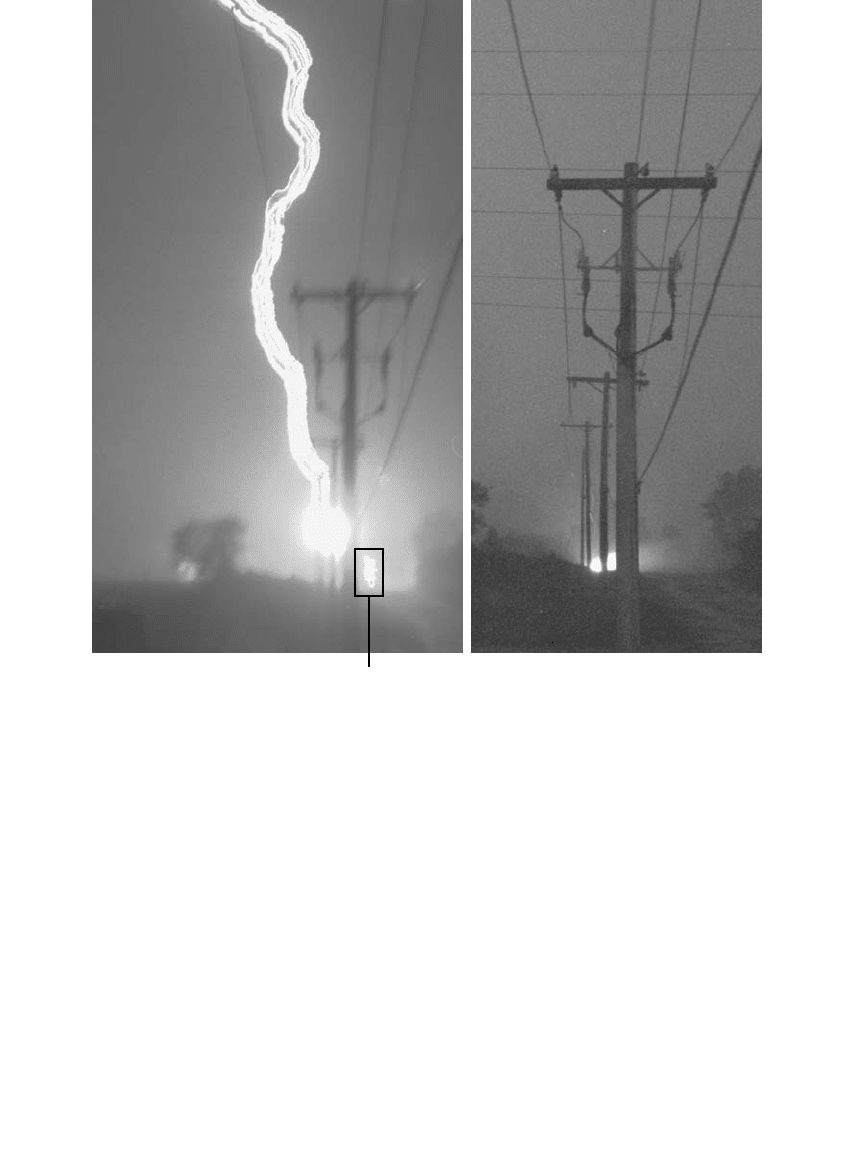
Lightning Protection
589
lightning and electrical breakdowns. Charles P. Steinmetz, Charles F. Wagner,
Walter W. Lewis, Karl B. McEachron, Charles L. Fortescue, Basil F. J. Schon-
land — the list of early contributors is long — increased our understanding
of the physics of lightning and its electrical characteristics.
Lightning is the electric breakdown of the air from high electric fields
generated when electric charge separates within a cloud. Lightning may flash
within a cloud, from one cloud to another, or from the cloud to the ground.
Distribution lines are only affected by cloud-to-ground lightning. In the nor-
mal scenario, charge separates within a thundercloud. The upper portion
becomes positively charged and the lower portion becomes negatively
charged. The ground just underneath the cloud becomes positively charged
FIGURE 12.1
Example of a lightning flash to a 13.2-kV distribution line and the downed wire that resulted.
(Copyright 1991, Niagara Mohawk Power Corporation. Reprinted with permission.)
(a) Lightning strike and flashovers
Supplementary flashovers
(b) Arcing downed conductor
1791_book.fm Page 589 Monday, August 4, 2003 3:20 PM
(C) 2004 by CRC Press LLC
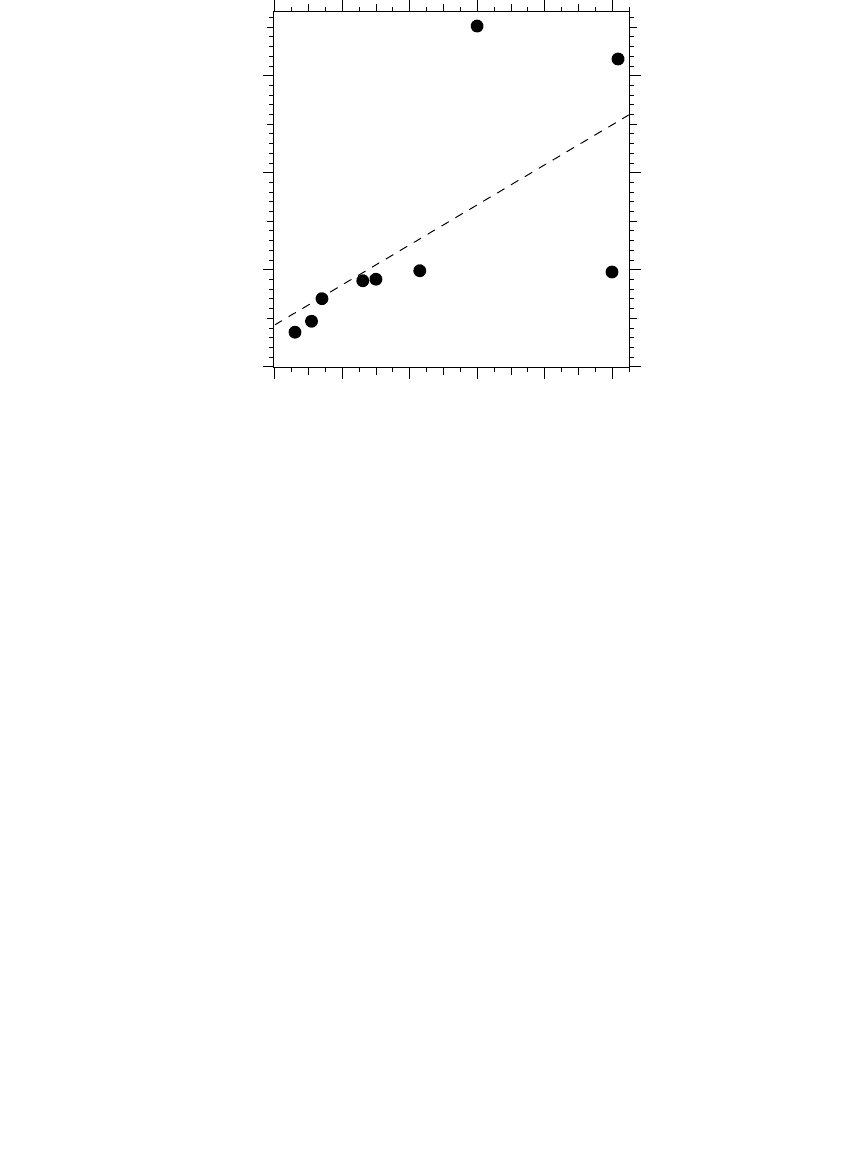
590
Electric Power Distribution Handbook
(being attracted to the negatively charged lower portion of the cloud). The
lightning breakdown begins in the lower portion of the cloud. The air breaks
down in steps called
stepped
leaders. Each step is about 150 ft (50 m) with
pauses of about 50
m
sec between steps. The stepped leader may fork and form
branches that each progress towards the ground. As the stepped leader
progresses closer to the ground (see Figure 12.3), more charge is lowered closer
to the ground. More positive charge collects on the earth in response — short
upward leaders extend to meet the downward negative stepped leader.
When the downward leader meets the upward leader, a
return stroke
occurs. The negative charge held in the stepped leader rushes into the
ground, brilliantly lighting the channel and creating a large pressure wave
(thunder). The return stroke propagates up the channel at roughly 20% of
the speed of light, releasing charge as it goes. The charge rushing into the
ground creates a current of tens of thousands of amps peaking in a few
microseconds. The current may extinguish in about 100
m
sec, or lower-level
continuing current in the range of hundreds of amperes may flow for several
milliseconds (about 25% of the time, continuing currents flow following the
return stroke).
Subsequent strokes
may follow the first stroke. After the current extinguishes
and the channel becomes dark, another pocket of charge may work its way
down the same path. Fast-moving leaders called dart leaders break down
the recently deionized path of the first stroke. Subsequent strokes typically
have lower magnitudes of current and charge transferred, but subsequent
stroke currents have higher rates of rise. Subsequent strokes have higher
FIGURE 12.2
Distribution line fault rate vs. ground flash density. (Based on the data in Figure 7.2.)
0 2 4 6 8 10
0
100
200
300
Ground flash density, flashes/km
2
/year
Fault rate per 100 miles per year
1791_book.fm Page 590 Monday, August 4, 2003 3:20 PM
(C) 2004 by CRC Press LLC
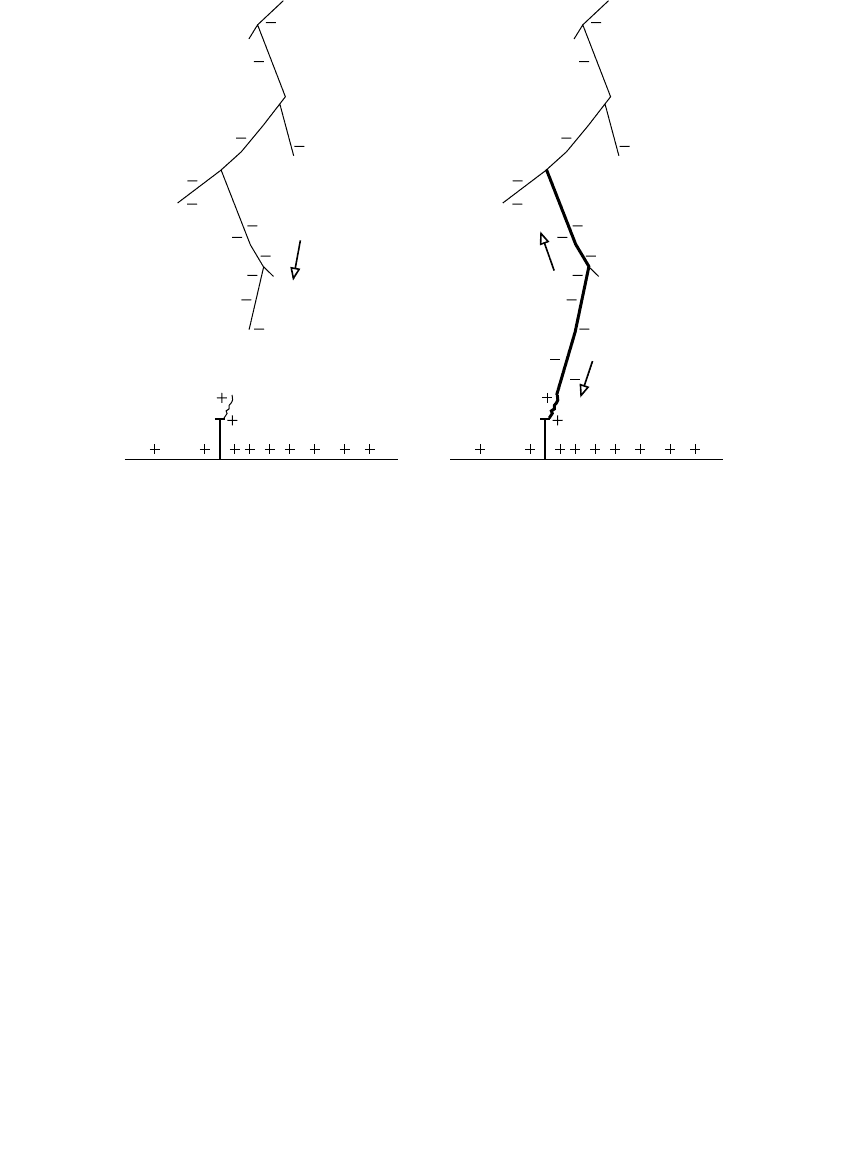
Lightning Protection
591
return-stroke velocities, often greater than 50% of the speed of light. The first
stroke and subsequent strokes make up a lightning
flash
.
While the downward negative flash is the most common, other types of
cloud-to-ground lightning occur. About 5 to 10% of cloud-to-ground flashes
are positive. Downward positive lightning lowers positive charge from the
cloud to the ground. Breakdown starts at a positive portion of the cloud
usually near the top of the cloud; a positive downward stepped leader moves
downward until it meets an upward negative leader close to the ground.
Some positive flashes may have very large peak currents and charge. Positive
flashes occur more often during winter storms, especially in some areas.
Positive flashes usually only have one stroke. Cloud-to-ground lightning
may also start at the ground and rise upward, with an upward stepped
leader starting at the ground. These are common on tall objects like the
Empire State Building, but rare from distribution lines.
Normally, the lightning current injection is considered an ideal current
surge (it does not really matter what is struck; the electrical characteristics
of the current stay the same). Table 12.1 shows characteristics of a downward
negative current flash. Many of the characteristics fit a log-normal distribu-
tion, which is common for data bounded at zero. The log standard deviation,
, is shown for the characteristics that have a log-normal char-
acteristic. The 5th and 95th percentiles are shown based on the log-normal
fit. The first stroke peak current data does not fit a log-normal distribution,
but Anderson and Eriksson found a good fit using two log-normal param-
FIGURE 12.3
Cloud-to-ground lightning.
Charge rushes
down the channel
Downward
stepped
leader
Return stroke
moves up
the channel
b=sd(ln( ))x
i
1791_book.fm Page 591 Monday, August 4, 2003 3:20 PM
(C) 2004 by CRC Press LLC

592
Electric Power Distribution Handbook
eters, one for low currents and one for high currents. Another common
approximation to Berger’s data for the probability of the peak magnitude of
a first stroke is (EPRI, 1982):
Table 12.2 shows characteristics for positive strokes. This data is not as
well defined since the data set is more limited.
Although most stroke and flash characteristics are independent of each
other, there are some interdependencies. Cigre (1991) examined correlations
TABLE 12.1
Lightning Current Parameters for Downward Negative Flashes
Parameter
Percent of Cases More than Value
b
5% 50% (
M
) 95%
First Strokes
Peak current, kA
Model for I
£
20kA
Model for I>20kA
8 33.3
61.1
33.3
90
1.33
0.61
Time to peak,
m
sec
(virtual front time based on the time
from 30 to 90% of the peak = T
30–90%
/0.6)
1.5 3.83 10 0.553
Steepness, 30–90%, kA/
m
sec 2.6 7.2 20 0.921
Tail, time to half the peak,
m
sec 30 77.5 200 0.577
Charge, C 1.1 4.65 20 0.882
Ú
I
2
dt, (A)
2
sec
¥
10
3
657546 1.373
Subsequent Strokes
Peak current, kA 5.2 12.3 29.2 0.530
Time to peak,
m
sec
(30–90% virtual front)
0.2 0.67 3.0
Steepness, 30–90%, kA/
m
sec 4.1 20.1 99 0.967
Tail,
m
sec 6.5 30.2 140 0.933
Charge, C 0.2 0.938 4 0.882
Ú
I
2
dt, (A)
2
sec
¥
10
3
0.6 5.5 52 1.366
Flash
Charge, C 1.3 7.5 40 1.02
Flash duration, sec 0.03 0.2 1
Number of strokes 1 2–3 9
Interval between strokes, msec 6 35 202 1.066
Sources:
Anderson, R. B. and Eriksson, A. J., “Lightning Parameters for Engineering Appli-
cations,”
Electra
, no. 69, pp. 65–102, March 1980a; Anderson, R. B. and Eriksson, A. J., “A
Summary of Lightning Parameters for Engineering Applications,” CIGRE Paper No. 33–06,
1980b; Berger, K., Anderson, R. B., and Kröninger, H., “Parameters of Lightning Flashes,”
Electra
, no. 41, pp. 23–37, July 1975.
P(
I
i
)=
+(
i
/
)
.
0
0
0
26
1
131
≥
1791_book.fm Page 592 Monday, August 4, 2003 3:20 PM
(C) 2004 by CRC Press LLC
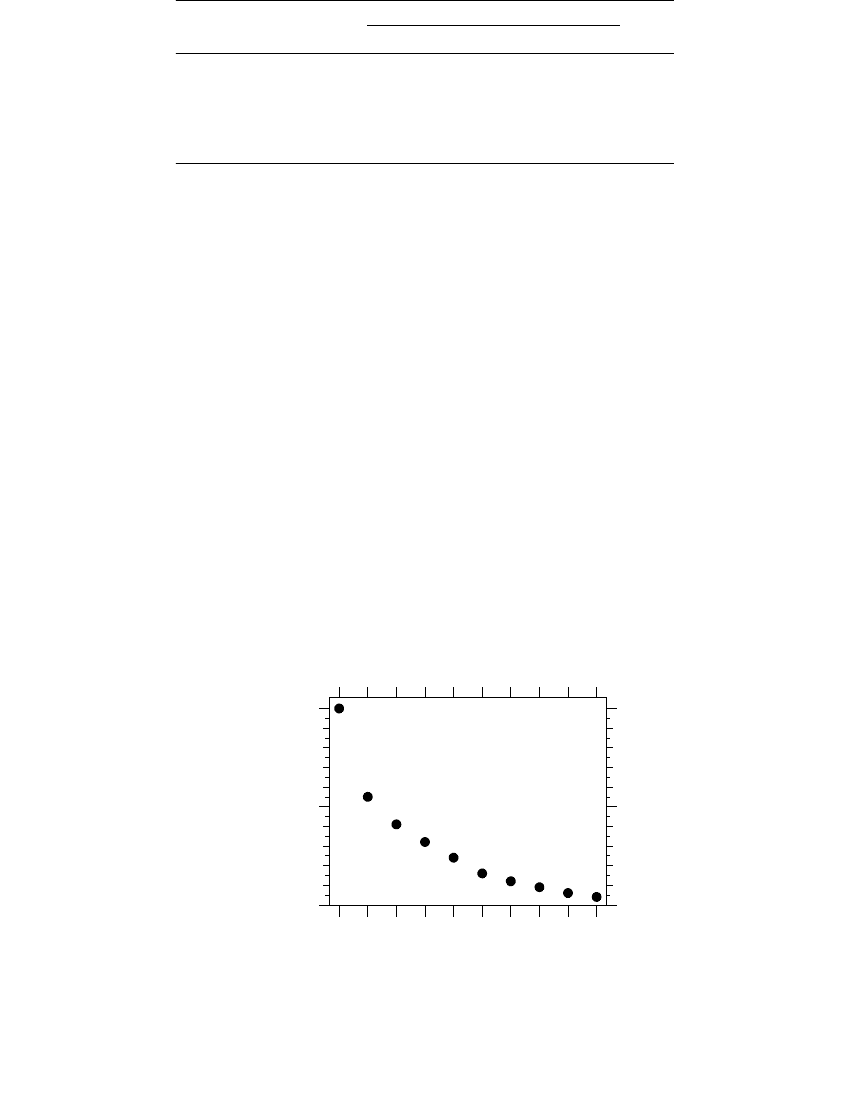
Lightning Protection
593
between various parameters. Larger first strokes tend to have longer rise
times. For first strokes, the equivalent front risetime correlates some with
the peak current; the average rate of rise does not. For subsequent strokes,
the peak current is independent of the rise time, although the peak current
partially correlates with the rate of rise. For both first and subsequent
strokes, the peak current correlates to some degree with the maximum rate
of rise. The correlations are not particularly strong in any of these cases.
Cigre used these interdependencies to find derived distributions that are
useful in some stochastic simulations.
More than half of cloud-to-ground lightning flashes are composed of more
than one stroke (see Figure 12.4). A quarter of them have at least four strokes.
The subsequent strokes usually have less current than first strokes, but the
rate of rise of current is higher (important for the inductive voltage rise,
L
d
i
/
d
t
, in arrester leads, arrester spacings on lines, and traveling-wave issues in
cables). Subsequent stroke characteristics are thought to be independent of
the first stroke.
A lightning flash may last more than 1 sec; this impacts line reclosing
practices. If a circuit breaker or recloser clears a lightning-caused fault and
TABLE 12.2
Lightning Current Parameters for Downward Positive Flashes
Parameter
Percent of Cases More than Value
b
5% 50% (
M
) 95%
Peak current, kA 5 35 260 1.21
Time to peak,
m
sec
(30–90% virtual front)
322140 1.23
Stroke charge, C 2 16 84 1.36
Flash charge, C 18 80 350 0.90
Source:
Berger, K., Anderson, R. B., and Kröninger, H., “Parameters of
Lightning Flashes,”
Electra
, no. 41, pp. 23–37, July 1975.
FIGURE 12.4
Number of strokes in a flash. (Data from [Anderson and Eriksson, 1980a,b].)
0
50
100
12345678910
Number of strokes in a flash
Probability of exceeding
the x-axis value
1791_book.fm Page 593 Monday, August 4, 2003 3:20 PM
(C) 2004 by CRC Press LLC

594
Electric Power Distribution Handbook
immediately recloses, a subsequent stroke may flash the line over again (or
continuing current in the flash may maintain the fault arc). About 5% of
lightning flashes will last beyond a typical immediate reclosing time of 0.5
sec (see Table 12.3). Normally, the extra fault will not cause any more dam-
age; the circuit breaker must open and reclose again. The practical effect of
this is to extend a half-second interruption to a 10-sec interruption (or
whatever the next delay time is in the reclosing sequence). It does show that
it is important to have more than one reclose attempt if an immediate reclose
is used.
A good percentage of multiple-stroke flashes have subsequent strokes to
different points on the ground (Thottappillil et al., 1992). This implies that
ground flash densities from flash counters and lightning detection networks
may underestimate the number of lightning flash ground terminations.
The lightning activity in an area can be measured. Many areas of the world
have lightning detection networks that measure the magnetic and/or electric
field generated by a lightning stroke, determine if the stroke is from cloud
to ground, and triangulate the stroke’s position. Such systems help utilities
prepare for storms; information on storm intensity, direction, and location
helps determine the number of crews to call up and where to send them.
Maps generated from lightning detection networks of
ground flash density
(GFD or
N
g
) are the primary measure of lightning activity. Figure 12.5 shows
a 10-year ground flash density contour map of the U.S. from the U.S. National
Lightning Detection Network (NLDN), which has been operating since
before 1990.
Lightning detection networks are also useful for correlating faults with
lightning. This data helps with forensics and is even used in real time to
direct crews to damage locations. From personnal experience with correlat-
ing faults with the U.S. NLDN and with camera monitoring studies, the
system successfully captures about 90% of strokes. The most important char-
acteristic that allows accurate correlation of faults and lightning is accurate
time tagging of power system event recorders including power quality
recorders, SCADA, or fault recorders (GPS works well). Position accuracy
of detection networks is not good enough to determine if strokes hit a line,
but it is good enough to narrow the choices of strokes considerably — almost
TABLE 12.3
Probability of a Successful Reclose Following a
Lightning-Caused Fault
Duration of the Dead Time
Before the Reclose, sec
Probability of a
Successful Reclosure
0.3 83%
0.4 90%
0.5 95%
Source:
Anderson, R. B. and Eriksson, A. J., “Lightning
Parameters for Engineering Applications,”
Electra
, no.
69, pp. 65–102, March 1980a.
1791_book.fm Page 594 Monday, August 4, 2003 3:20 PM
(C) 2004 by CRC Press LLC
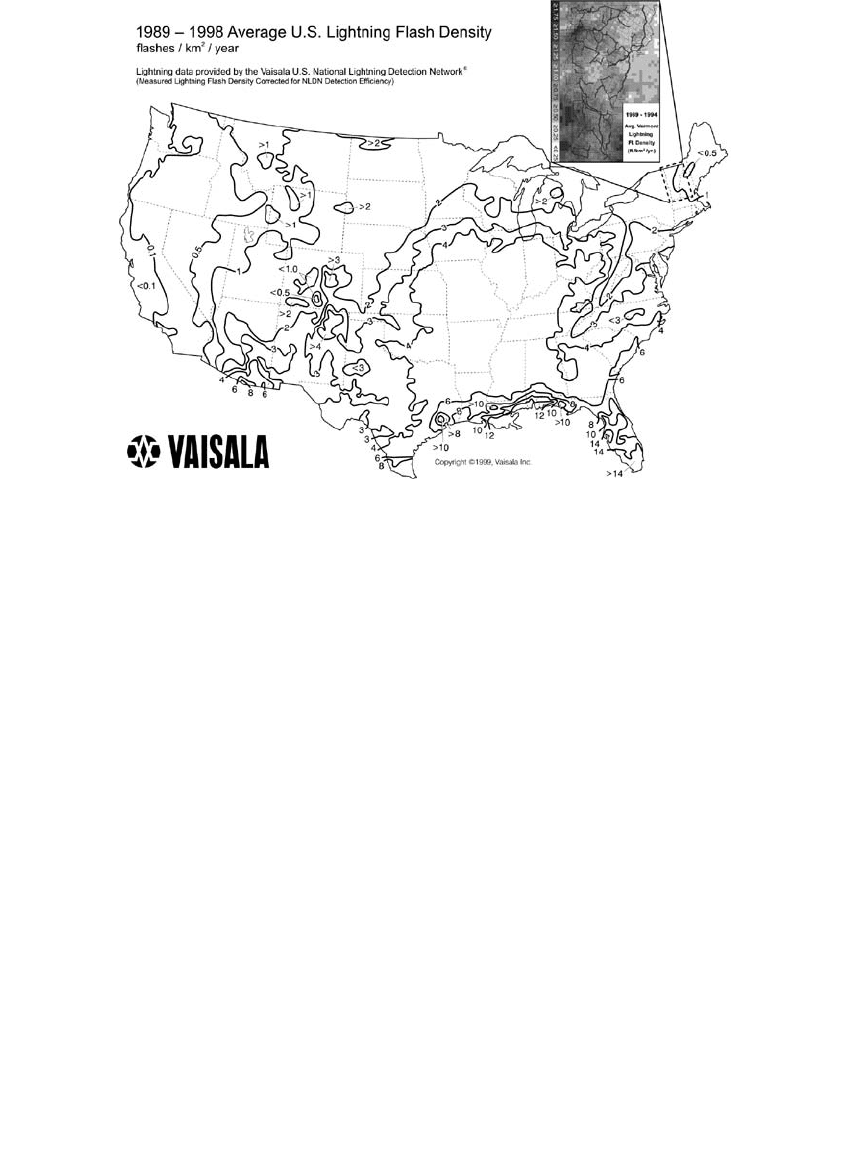
Lightning Protection
595
all strokes found by the U.S. NLDN are accurate to within 1 mi (1.6 km),
with most accurate to 2000 ft (0.5 km).
If direct measurements of ground flash density are unavailable, meteoro-
logical records of thunderstorms are available, most commonly the number
of days with thunderstorms (or keraunic level). Thunderstorm days approx-
imately relate to ground flash density as (Eriksson, 1987):
Records of the number of thunderstorm hours per year relate to
N
g
as
(MacGorman et al., 1984):
where
T
h
is the number of thunderstorm hours per year.
Another crude estimate of the lightning level is from NASA’s Optical
Transient Detector, which measured worldwide lightning activity for 5 years
(Chisholm et al., 1999).
Lightning is highly variable. It takes several hundred lightning flash counts
to obtain modest accuracy for an estimate of the average flash density. A
FIGURE 12.5
Ground flash density from the United States National Lightning Detection System. (Lightning
map provided by Vaisala.)
NT
g
d
= 004
125
.
.
NT
g
h
= 0 054
11
.
.
1791_book.fm Page 595 Monday, August 4, 2003 3:20 PM
(C) 2004 by CRC Press LLC

596
Electric Power Distribution Handbook
smaller geographic area requires more measurement time to arrive at a
decent estimate. Similarly, a low-lightning area requires more measurement
time to accurately estimate the lightning. Standard deviations for yearly
measurements of lightning activity range from 20 to 50% of the mean (IEEE
Std. 1410-1997). Figure 12.6 shows the variability of ground flash density in
a high-lightning area. Lightning and storms have high variability. Lightning
and weather patterns may have cycles that last many years.
Distribution lines cover small geographic areas, so lightning damage and
lightning flashover rates show high variability on a circuit. One year a circuit
may get nailed with damage coming from many storms; the next year it may
have next to nothing.
The variability of lightning and the variability of storms is also important
for utility planning regarding regulatory incentives for reliability and for
performance guarantees for customers. Just a few years of data usually does
not accurately depict the performance of weather-related events for a circuit
or even for a whole system.
12.2 Incidence of Lightning
Lightning flashes hit typical-height distribution lines that are in the open at
the rate of about 17 flashes/100 circuit mi/year for an area with
N
g
= 1
FIGURE 12.6
Estimated annual ground flash density for Tampa, Florida based on thunderstorm-hour mea-
surements. (Data from [MacGorman et al., 1984].)
1950 1960 1970
0
5
10
15
20
25
Year
Ground flash density, flashes/km
2
/year
1791_book.fm Page 596 Monday, August 4, 2003 3:20 PM
(C) 2004 by CRC Press LLC

Lightning Protection
597
flash/km
2
/year (11 flashes/100 km/year). Flashes to lines vary directly as
the ground flash density. Almost all of these flashes to lines cause faults,
and some damage equipment. Taller lines attract more flashes. The most
accepted model of lightning strikes to power lines in open ground is Eriks-
son’s model, which finds the number of strikes as a function of the line
height (Eriksson, 1987):
where
N
= flashes/100 km/year to the line
N
g
= ground flash density/km
2
/year
h
t
= height of the conductor (or overhead groundwire) at the tower, m
b
= overhead ground wire separation, m
For distribution lines, the
b
term can be ignored, which gives:
for
h
in meters and
N
in flashes/100 km/year, or
for
h
in feet and
N
in flashes/100 mi/year.
For a 30-ft (10-m) line, about 17 flashes/100 mi/year (10.6 flashes/100 km/
year) hit a distribution line for
N
g
= 1 flash/km
2
/year. The main data point
for distribution lines is a South African test line heavily monitored in the
1980s (Eriksson, 1987). The test line had 19 flashes/100 mi/year (12 flashes/
100 km/year) normalized for
N
g
= 1 flash/km
2
/year for a line height of 28
ft (8.6 m).
The equivalent shadow width or total width that a distribution line attracts
lightning is on the order of 360 ft (110 m). This is about 12 times the line
height. For many years, a shadow width of four times the line height was
used; this model underestimates the number of flashes hitting lines.
More exposed lines — those with no trees nearby or lines on the tops of
ridges — attract more flashes. Eriksson’s equation is for a line in open
ground. Many lines have fewer hits because of shielding from nearby objects
(mainly trees, but also buildings and other power lines). For lines in forested
areas, the number of strikes is significantly reduced, so this equation should
be an upper limit for most lines. Some very exposed lines on hills may have
more hits than Eriksson’s equation predicts. The number of hits to a line in
a shielded area is:
NN
hb
g
=
+
Ê
Ë
Á
ˆ
¯
˜
28
10
06.
NNh
g
=◊28
06
.
.
NNh
g
=◊22
06
.
.
1791_book.fm Page 597 Monday, August 4, 2003 3:20 PM
(C) 2004 by CRC Press LLC
